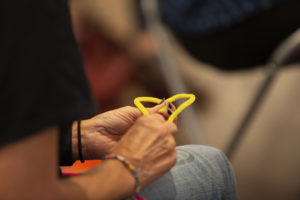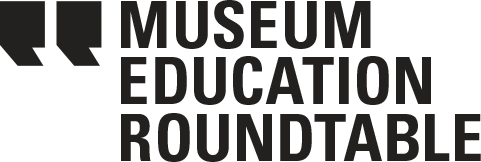JME in Action: The Third Space, Cultural Hybridity and The Art Museum
The Journal of Museum Education’s issue On the Floor: Museum Teaching Techniques in the 21st Century includes the article “Empowering Identity Through Art: Bilingual Co-Teaching at the Blanton Museum of Art.” Here, one of the co-authors, Sabrina Mooroogen-Phillips, describes the “intimate task of unraveling our culture” with teachers.
In the fall of 2018, The Blanton Museum of Art in Austin, Texas started hosting Cultural Proficiency workshops for K-12 educators and administrators school wide. This meant that an entire faculty, including the principal, took advantage of the School District’s (Austin Independent School District, AISD) Innovation Day and went on a field trip to the local art museum. Here’s what happened.
I first came to thinking about Cultural Proficiency through Zaretta Hammond’s book Culturally Responsive Teaching and the Brain, a widely read book throughout our district. As a former classroom teacher, and now museum educator, I wondered “what does culture mean to me?” and “how do I know if I’m proficient and responsive?” I was stumped. Thankfully, I was not the only one. It seemed that many schools were grappling with the concepts, caught between ingrained school systems and their desire to move forward in equity.
The museum workshops last only two hours, and in that time my goal for the teachers is to walk away with a deeper understanding of what culture means to them personally, within their schools, and community. So not much!
Asking one to define their culture, or to explain it is not easy. In fact, it’s possible to view culture as many of us have learned, as traditional dress, language, foods and holidays. That’s not to say that it isn’t those things, but it isn’t only those things. What happens if none of the above applies to you, because perhaps your culture never had to be taught?
What role then, can a museum play in helping to foster an understanding of all our personal deep cultural contexts, so that we can start to move away from the disconnected tokenization of culture?

Trenton Doyle Hancock Painter and Loid Struggle for Soul Control, 2001, Blanton Museum of Art, University of Texas, Partial and pledged gift of Jeanne and Michael Klein, 2001
In October the whole staff of a local elementary school joined us for a day at the Blanton. The thirty-five educators were divided in half and brought into the gallery space. My group joined me in front of Trenton Doyle Hancock’s Painter and Loid Struggle for Soul Control.
I often describe this incredibly beautiful artwork as my brain, visualized. It turns out again, I’m not the only one. This work is unframed, consists of raw canvas, found materials, such as shoe soles, and milk bottle caps, colorful trees and strange creatures. The tree branches that permeate the canvas are filled with the text ‘You Deserve Less’. This message is also seen cut out of the actual canvas, its letters thrown into a sandwich bag and nailed to the artwork.
The group were invited into ‘a third space’ both physically and mentally. The words spoken, the accents heard, and the perspectives articulated allowed for meaning to be co-created as this elementary school’s cultural identity shifted and took new shape in that moment.
I asked the educators to take time to look at all the elements of this work, of which there are many. Their eyes always coming back to the pervasive message ‘You Deserve Less’. We sat down, got comfortable, got close and began the intimate task of unravelling our culture. I spoke first. I showed the group two symbols I had made from pipe cleaners and talked about what each meant for me. The first a divide symbol that represented what it is like for me to be both British and of South Asian descent, how the legacy of the empire reminds me that ‘you deserve less.’ I was socialized into a state of near constant othering that I then internalized. The next, an open circle representing how it feels to be a working mother of three, and the continuous shame and guilt that invades my thinking, reminding me ‘you deserve less’. I was socialized to believe this with statements like “You’ll never get this time back”, or “What does your husband do for work?” This is the hybridity of my cultural context. It has to do with race, nationality, gender, identity, socialization, age, awareness and much more other ingrained and internalized notions both positive and negative, in flux and continuously being co-created with those around me.
 I asked the educators to create two symbols for themselves to represent their contexts. Once made, they were invited to turn to the person next to them and, to share what they made and why. I asked teachers to be as vulnerable as they felt comfortable. What followed was a beautiful display of solidarity, understanding, and resonance. The teachers’ bodies were turned toward each other, as if sharing a secret, their eyes fully open, and both tears and laughter could be heard. I asked the group how did it feel to share your hybrid cultural contexts? Refreshing, relief, empowered, emotional were some of the responses. I asked, how did it feel to bear witness to someone else’s cultural story? Privileged, honored, quiet, bonded.
I asked the educators to create two symbols for themselves to represent their contexts. Once made, they were invited to turn to the person next to them and, to share what they made and why. I asked teachers to be as vulnerable as they felt comfortable. What followed was a beautiful display of solidarity, understanding, and resonance. The teachers’ bodies were turned toward each other, as if sharing a secret, their eyes fully open, and both tears and laughter could be heard. I asked the group how did it feel to share your hybrid cultural contexts? Refreshing, relief, empowered, emotional were some of the responses. I asked, how did it feel to bear witness to someone else’s cultural story? Privileged, honored, quiet, bonded.
Imagine if, those deepening relationships of lovingly, honestly, and collectively exploring culture was happening in the classroom, with our students. Perhaps, the habitual cultural disconnect could be replaced by supportive cultural consciousness.
Sabrina Mooroogen-Phillips, MA, leads school programs at the Blanton Museum of Art. She has taught visual arts at schools in England, Thailand, Egypt, and Qatar. She is currently pursuing a doctorate in Education and Social Justice at Lancaster University, UK.
Bibliography:
Bhabha, H.K. (1994) ‘The Location of Culture’ New York: Routledge.
Freire, P. (1974) ‘Education for Critical Consciousness’, Bloomsbury Academic.
Hammond, Z. (2015) ‘Culturally Responsive Teaching and the Brain: Promoting Authentic Engagement and Rigor among Culturally and Linguistically Diverse Students’, California: Sage Company.
hooks, b. (1994) ‘Teaching to Transgress: Education as the Practice of Freedom’, New York: Rutledge.

